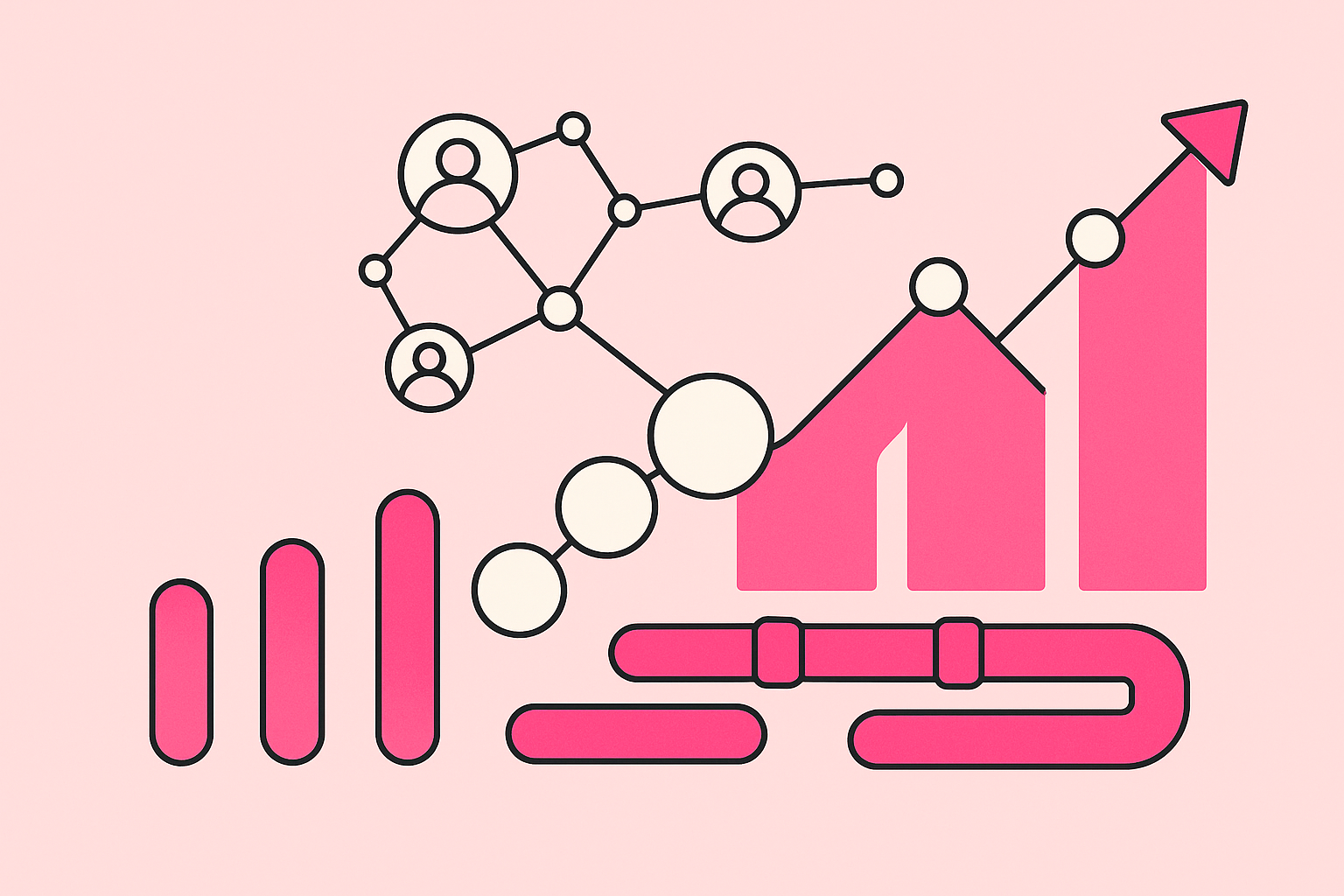
Most B2B marketers still think podcasts are just brand awareness plays.
They're wrong. Dead wrong. And leaving millions on the table because of it.
The reality?
B2B podcast ROI in 2025 is measurable, attributable, and driving 3-5x returns for companies that treat their shows like revenue engines, not vanity projects. While your competitors chase download counts and "thought leadership," the smartest B2B podcast strategies are quietly generating 20-30% of new pipeline through strategic guest relationships and dark social amplification.
The stakes have never been higher. With marketing budgets under microscope-level scrutiny and every channel fighting for survival, the old "trust me, it's working" approach to B2B podcasting is dead. CFOs want receipts. CEOs want pipeline impact. And if you can't connect your podcast to revenue, you're one budget review away from cancellation.
Here's what's actually happening: B2B podcasting companies that nail attribution are seeing podcasts influence up to 40% of enterprise deals. They're shortening sales cycles by 23%. They're turning every episode into a Trojan horse for account penetration. And they're doing it with frameworks you won't find in any "how to start a podcast" guide.
Ready to discover if your current podcast strategy is capturing its full revenue potential or hemorrhaging opportunity?
Let’s break down what’s actually driving ROI.
The New B2B Podcasting Landscape
2025 B2B Podcasting Trends: What's Actually Driving Results?
Download obsession is killing podcast ROI. While marketing teams celebrate hitting 10,000 monthly downloads, the companies actually driving revenue from their B2B podcast focus on an entirely different set of metrics. 50% of B2B marketers plan to increase podcast budgets in 2025, yet most still measure success like it's 2015.
The shift is stark. Leading companies track pipeline influence and deal velocity, not vanity metrics. When 83% of C-suite executives consume podcasts weekly, the opportunity isn't about reach; it's about reaching the right accounts at the right time. Fame clients allocate 15-20% of their content marketing budget to podcasting, compared to the industry average of 5-8%, because they understand the dark social dynamics that traditional attribution misses.
Modern B2B podcasting operates in the shadows of conventional measurement. Your prospect listens during their commute, discusses insights with their team on Slack, then shows up on a sales call three months later, citing your episode. Traditional analytics capture none of this. The companies winning this game have shifted from counting ears to tracking influence, measuring how podcast touchpoints accelerate deals through the pipeline.
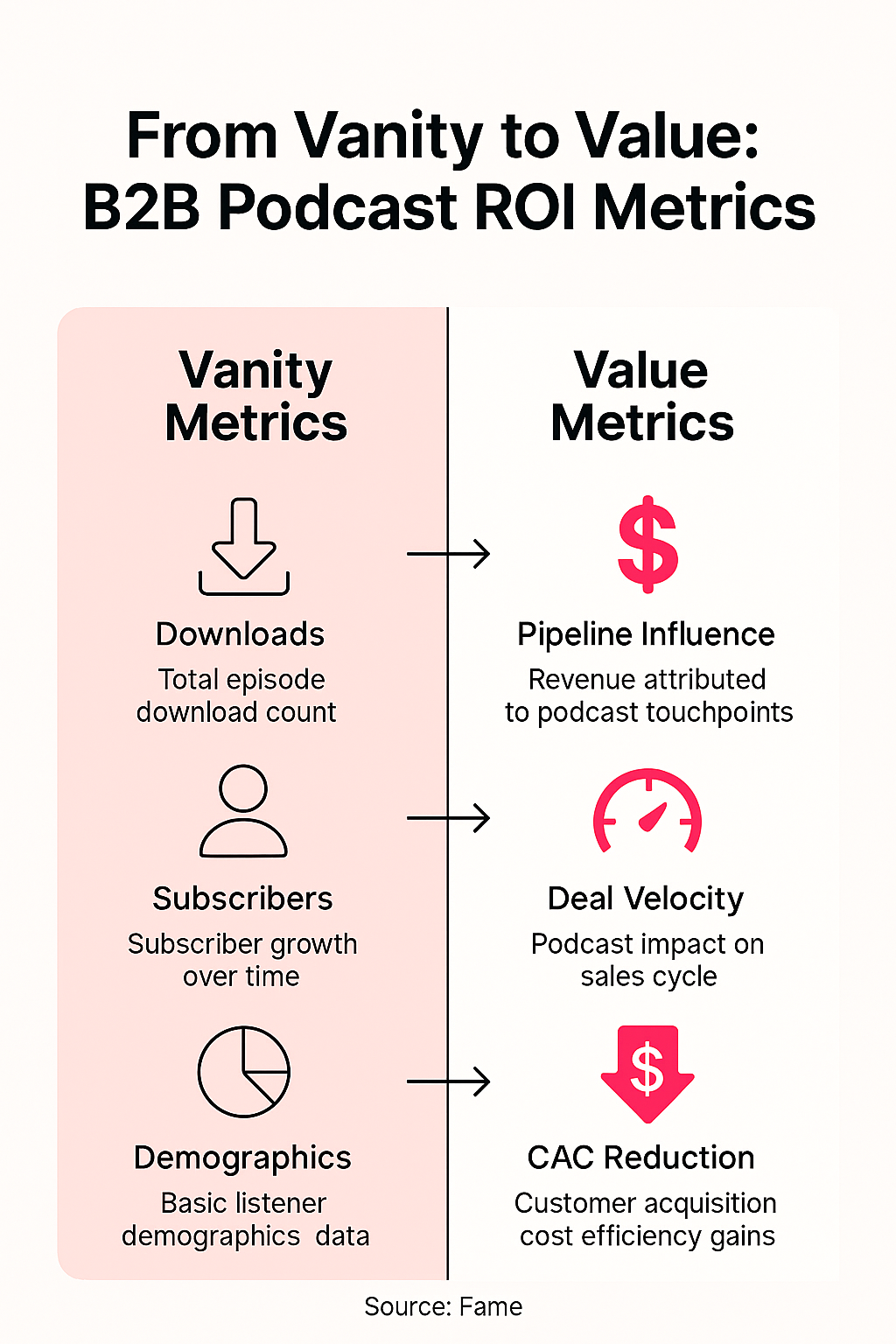
According to Fame's analysis of 100+ B2B podcasts, the total podcast audience is growing at a compound average growth rate of 20%, creating unprecedented opportunities for strategic brands. But here's what most miss: 80% of podcast audiences listen to the entire episode or most of it, meaning you hold executive attention for 20-50 minutes, a feat impossible with any other content format.
Audience Dynamics and Buyer Behavior
The link between podcast consumption and purchase decisions runs deeper than most B2B podcasting company strategies acknowledge. Decision-makers don't just listen, they integrate podcast insights into their evaluation process. 53% of weekly B2B podcast listeners directly influence purchasing decisions, yet most shows still chase broad appeal over buyer relevance.
Pipeline gravity, the invisible force that pulls deals toward closure, intensifies when prospects consume your podcast content. Fame's data shows 22% of closed-won deals include podcast touchpoints in the buyer journey, typically uncovered through self-reported attribution. One SaaS client discovered that their average deal size increased by 34% when prospects engaged with podcast content before entering the sales process.
Dark social amplifies this effect. Your target account's VP shares an episode in their leadership Slack channel. The CFO listens during their flight to a board meeting. The CEO references your framework in their strategy session. None of this shows up in your analytics, but it shapes the buying conversation. Smart companies design their podcast strategy around these invisible influence patterns, not download charts.
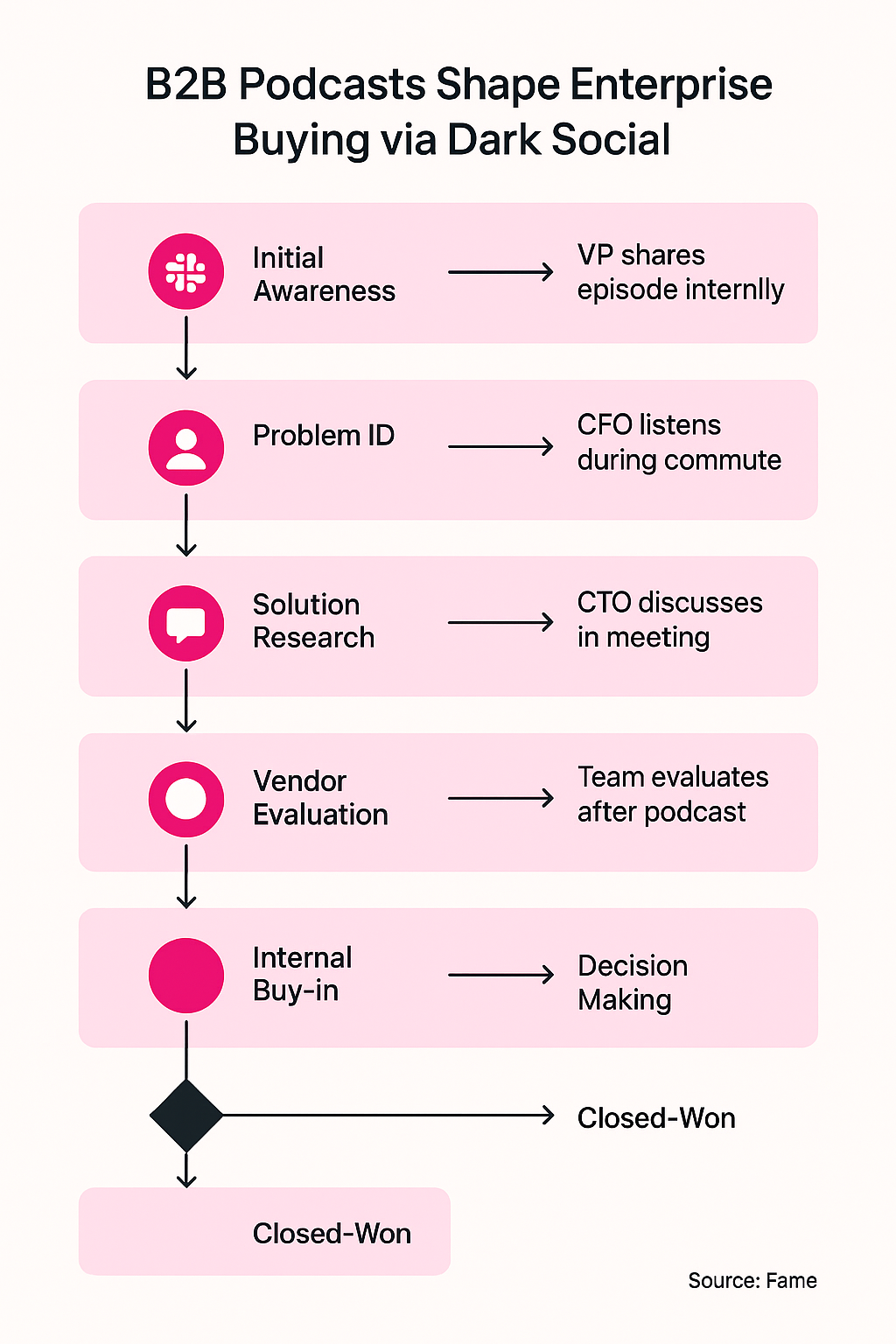
The most successful B2B podcasts recognize that each episode serves multiple channels simultaneously. As Fame's research reveals, B2B podcasts effectively straddle SEO (with each episode optimized for relevant long-tail keywords), SDR/Sales (through deals originated from guest relationships), and Partnerships (via strategic connections formed with podcast guests). This multi-channel impact creates compound returns that traditional content formats simply can't match.
ROI, Pipeline, and Performance Benchmarks
ROI Benchmarks by Industry and Company Size
The industry data tells a story most B2B podcasting companies won't share: actual ROI varies dramatically based on strategic execution, not just sector. Our analysis of 100+ B2B podcasts reveals performance benchmarks that challenge conventional wisdom about podcast marketing effectiveness.

SMB tech companies (under $20M ARR) see faster initial returns, typically achieving positive ROI within 6 months, while enterprise organizations leverage podcasts for longer-term category positioning plays. The critical difference? SMBs focus on guest-to-customer conversions while enterprises chase audience metrics that rarely correlate with revenue.
Fame's knowledge base reveals a crucial insight: regardless of how long-term your business thinks, you need to ascertain B2B podcast ROI from any channel during its first year. Without this, justifying continued investment becomes impossible. The solution lies in understanding B2B podcasting's dual ROI structure.
Reality Check: 73% of B2B podcasts track the wrong metrics because their agencies optimize for production volume, not business outcomes. Fame's ROI Master Working Procedure™ flips this model, starting with revenue attribution before recording a single episode.
Fame's Proprietary ROI Frameworks
The dual ROI approach transforms B2B podcasts from content initiatives into revenue engines. Guest-Side ROI captures immediate wins through strategic relationship building, while Audience-Side ROI compounds over time through pipeline influence and category authority.
Guest-Side ROI (Months 1-6):
- Target: Book ideal customers as guests
- Convert: Transform conversations into commercial opportunities
- Measure: Direct pipeline attribution from guest relationships
Audience-Side ROI (Months 6+):
- Build: Develop category authority through consistent thought leadership
- Nurture: Create touchpoints throughout the buyer journey
- Track: Multi-touch attribution across listener engagement
Based on Fame's proven framework, a $20K year-one investment typically yields:
- 24 episodes produced
- 10K downloads per month
- 1K extra website sessions monthly
- 10 potential customer relationships
- 5 potential partnership opportunities
With proper execution, closing just one customer ($15K value) and one partnership ($10K value) creates cash-positive ROI, making all audience-building metrics essentially free. This approach works best when average customer value exceeds $5K in year one.
One Fame client in cybersecurity generated $340K in attributed pipeline within 9 months: 65% from guest relationships, 35% from audience engagement. Their secret? Treating every episode as a strategic business development opportunity, not just content creation.
The framework's power lies in its measurement sophistication. While competitors count downloads, we track self-reported attribution, CRM touchpoints, and deal influence metrics that CFOs actually recognize.
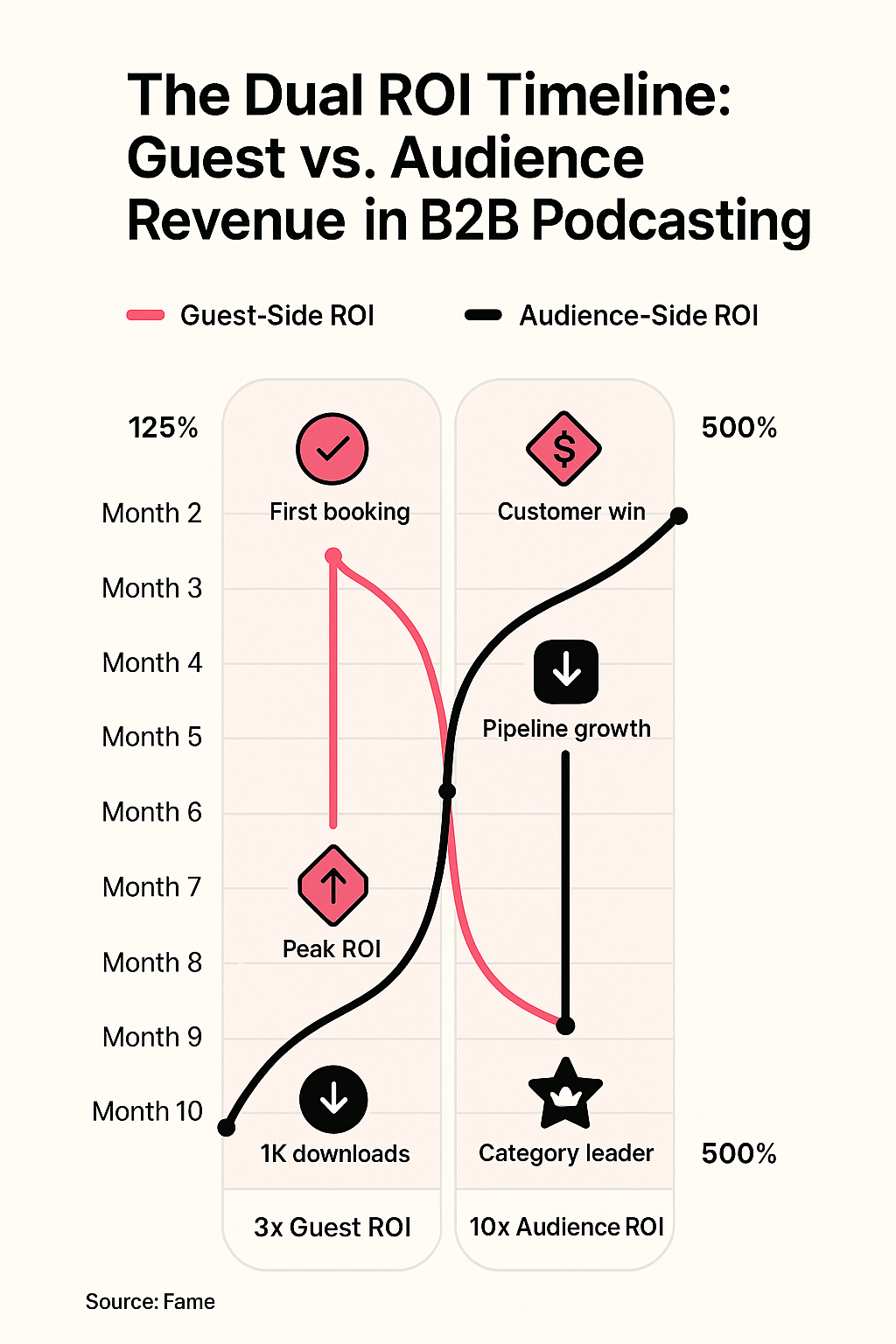
Strategic execution beats tactical perfection; companies implementing this framework see 3.2x higher ROI than those chasing production quality alone.
Best Practices for Audience Growth & Pipeline Conversion
Pipeline-First Content Strategy
Stop creating content for everyone. Start creating content for buyers with a budget.
The most effective B2B podcasting company strategies begin with reverse-engineering from your ideal customer's pain points. Map your episode topics directly to the problems keeping your buyers awake at 3 AM. When a SaaS platform shifted from generic "leadership insights" to specific episodes on "reducing customer acquisition costs in competitive markets," their qualified lead volume increased by 47% in four months.
Strategic guest selection becomes your secret weapon. Target decision-makers who control budgets for solutions like yours. Frame your outreach around their expertise in solving specific challenges, not their title or company size. This approach transforms interviews from content creation into relationship acceleration.
Your episode framework determines conversion potential:
- The Prospect Spotlight: Feature ideal customers solving relevant challenges to attract similar accounts
- The Problem-Solution Arc: Structure episodes around specific pain points your solution addresses
- The Expert Roundtable: Position your brand alongside recognized authorities in your space
Based on Fame's dual ROI methodology, the most successful shows bring on guests who could be good customers or partners. The key? Never pitch during the interview. Instead, focus on making every guest have an amazing experience, show genuine gratitude, and maintain the relationship post-recording. This approach consistently generates deals within 6 months.
One client transformed their podcast from a brand awareness play to a pipeline engine by implementing this framework. Result? $340K in attributed pipeline within 9 months.
Every episode should double as sales enablement content.
Repurposing and Distribution Strategy
Recording is only 20% of success; distribution is 80%.
The highest-performing B2B podcast strategies leverage Fame's Repurposing Flywheel, a systematic approach to transforming one episode into 10+ pipeline-driving assets. Each 45-minute conversation becomes blog posts, LinkedIn carousels, email sequences, sales collateral, and executive briefings.
According to Fame's measurement data, repurposed content from podcasts can be used to create long-form blog content, show notes, email newsletters, and social media captions, multiplying ROI from a single recording session. This approach recognizes that B2B podcasts straddle multiple channels: SEO (through keyword-optimized episode pages), SDR/Sales (through guest relationships), and Partnerships (through strategic connections).
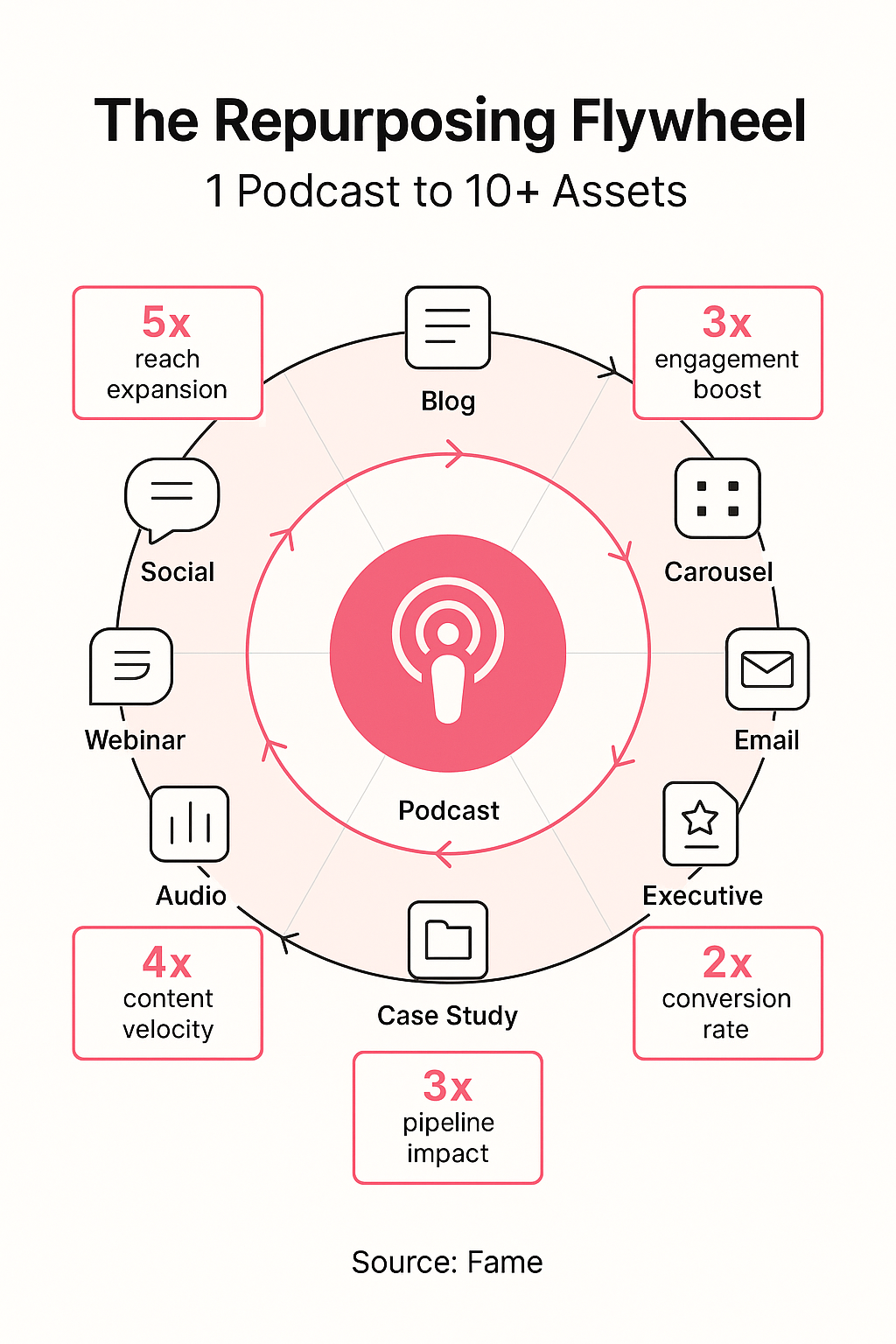
Distribution channels that actually drive pipeline focus on dark social and zero-click environments. Seed episode clips in private Slack communities, industry Discord servers, and LinkedIn DMs where your buyers actually spend time. Public feeds capture awareness; private channels capture intent.
Repurposed content consistently outperforms original episodes in driving conversions. One technology services firm saw 3.2x higher engagement on LinkedIn video clips than full episodes, with direct message inquiries increasing by 78%.
Your distribution strategy should prioritize channels where attribution hides but conversions happen.
Technology, Measurement, and the Fame Methodology
The Complete B2B Podcast Tech Stack
Your podcast tech stack determines whether you're measuring B2B podcast ROI or just counting downloads like it's 2015. The foundation starts with CRM integration, and every guest interaction, listener touchpoint, and engagement signal must flow directly into your revenue systems. Without this connection, you're flying blind while competitors attribute millions to the pipeline.
Basic podcast analytics tell you how many people pressed play. Advanced measurement reveals which episodes influenced the $500K enterprise deal that closed last quarter. The difference lies in three core components: multi-touch attribution tools that track podcast influence across the buyer journey, behavioral analytics that identify high-intent listeners, and integration APIs that sync podcast data with your existing martech stack. One SaaS client implemented this framework and discovered their podcast influenced 42% of qualified pipeline, invisible revenue that their basic hosting platform never revealed.
Fame's approach recognizes that B2B podcasting success requires measuring both short-term relationship-driven ROI (customers/partnerships generated through guest relationships) and long-term audience-driven ROI (leads/customers generated through the audience). The first year ROI typically comes through strategic guest relationships, with audience benefits materializing in years two through five.
The implementation roadmap isn't complex; it's just ignored by agencies focused on production over performance. Start with your CRM as the source of truth, layer in attribution tracking through UTM parameters and self-reported fields, then connect behavioral signals through marketing automation. Fame's proprietary technology automates this entire flow, turning every episode into a trackable revenue event rather than a content black hole.
Why Most B2B Podcasting Companies Get It Wrong
Here's what separates Fame from every other B2B podcasting company: we're marketers who podcast, not podcasters who pretend to understand marketing. While traditional agencies celebrate download milestones, we're tracking pipeline influence, deal velocity, and customer acquisition costs. The difference? We guarantee 10% monthly download growth because we're accountable for commercial results, not just clean audio files.
Audio-first agencies miss the fundamental truth about B2B podcasts: they're relationship accelerators, not entertainment channels. They'll perfect your sound quality while ignoring the fact that one strategic guest conversation can generate more revenue than 10,000 anonymous downloads. Our operator-led approach means every decision, from guest selection to episode topics, ties directly to your revenue goals. We've seen clients close $2.4M in attributed pipeline while their previous agency was still celebrating hitting 1,000 downloads.
The data backs this up: according to Nielsen's Podcast Listener Buyer Power database, the total podcast audience is growing at a compound average growth rate of 20%. But growth without revenue focus is just expensive noise. Fame's methodology ensures that growth translates to pipeline, not just podcast awards.
The evaluation framework that matters isn't about production capabilities or audio expertise. It's about commercial accountability, pipeline attribution, and the ability to turn conversations into contracts. Fame's methodology delivers what C-suite executives actually care about: measurable business impact, not podcast awards.
From Strategy to Implementation: Your B2B Podcast ROI Roadmap
The gap between podcast strategy and measurable revenue isn't capability, it's execution. Most companies stall at launch because they lack a systematic approach to transform their B2B podcast from a content experiment to a pipeline engine. The difference between podcasts that generate meetings and those that generate millions lies in following a proven implementation framework.
Your 90-Day Sprint to Revenue-Generating Podcast
Days 1-30 focus on foundation building. Define your guest persona with surgical precision, not "marketing leaders" but "VPs of Marketing at Series B SaaS companies with 50-200 employees facing attribution challenges." Lock down your show positioning to address a specific pain point that your ideal customers lose sleep over. One B2B podcasting company client refined their targeting from "sales leaders" to "RevOps directors scaling from founder-led sales" and saw guest acceptance rates jump from 12% to 47%.
Days 31-60 shift to relationship acceleration. Launch with four pre-recorded episodes featuring your highest-value prospects as guests. Structure each conversation around their biggest operational challenge, the one your solution happens to solve. Implement post-recording follow-up sequences that convert warm conversations into discovery calls. When executed properly, this phase generates initial B2B podcast ROI through direct guest relationships before you've even built an audience.
Days 61-90: Scale what works. Double down on the guest profiles generating pipeline. Refine your outreach messaging based on acceptance patterns. Launch your multi-channel distribution strategy to amplify each episode's reach. Our clients typically see their first attributed deal close within this window. One technology services firm closed $180K in new business from podcast relationships before hitting their 10th episode.
Fame's proven approach shows that investing $20K in year one typically generates 24 episodes, builds relationships with 10 potential customers and 5 potential partners. With the right process, closing just one customer ($15K value) and one partnership ($10K value) creates cash-positive ROI, making all audience-building metrics essentially free bonuses.
Essential Elements Checklist:
- Guest scoring matrix aligned to ICP fit
- The episode structure is optimized for conversion conversations
- CRM integration for relationship tracking
- Post-recording nurture sequences
- Attribution framework for pipeline measurement
- Executive buy-in with defined success metrics
The Three Implementation Killers (And How to Avoid Them)
- The Perfection Trap: Waiting for studio-quality production before launching. Reality: Your first customer cares about valuable conversation, not audio engineering. Start with good-enough quality and iterate.
- The Audience Obsession: Chasing download numbers instead of relationship value. Reality: Ten strategic conversations with decision-makers outweigh 10,000 random listeners.
- The Attribution Void: Failing to connect podcast activities to the pipeline. Reality: Without proper tracking, you'll kill a working channel due to invisible ROI.
Smart operators recognize that B2B podcast success requires more than recording conversations. It demands systematic execution, relationship discipline, and revenue focus from day one.
Transform Your Podcast From Cost Center to Revenue Engine
B2B podcasting in 2025 isn't about downloads, impressions, or vanity metrics that impress marketing teams but fail to move revenue needles. The strategic shift from content creation to pipeline generation represents the most significant evolution in B2B marketing since account-based strategies went mainstream. Companies that master this transformation don't just build audiences, they build empires.
The old playbook treated podcasts as awareness plays, measuring success through reach and engagement while deals died in attribution black holes. Today's leaders track B2B podcast ROI through CRM-integrated touchpoints, guest-to-customer conversions, and multi-touch revenue models that prove impact at every stage. One Fame client transformed their "failed" podcast into a $2.3M pipeline generator simply by shifting measurement from downloads to deals.
Your competitors are still chasing download milestones while you could be closing enterprise accounts. The companies dominating their categories in 2025 won't be those with the biggest audiences; they'll be those who turned conversations into contracts, relationships into revenue, and content into category ownership.
Fame's dual ROI methodology proves the point: strategic guest relationships can generate immediate returns (often achieving cash-positive ROI within year one), while audience-building compounds value over time. The crucial insight? You don't need 10,000 downloads to drive revenue; you need 10 strategic conversations with the right decision-makers.
The window to establish podcast-driven market leadership narrows daily. Every week you delay implementation, competitors book your ideal customers as guests, capture mindshare in your category, and build the trust moats that should protect your market position.
Ready to transform your B2B podcast from a content experiment to a pipeline-driving engine?
Get your proposal.
FAQs
What’s the real strategic value of a B2B podcast for technology and professional services brands in 2025?
B2B podcasts are no longer about mass awareness; they’re pipeline accelerators. With 83% of C-suite execs listening weekly and 22% of closed-won deals including podcast touchpoints, the right show can drive 8-12% of total pipeline, increase average deal size by 34%, and build category authority that competitors can’t touch.
How should we measure ROI for a B2B podcast, and what benchmarks actually matter?
Forget downloads, track pipeline influence, deal velocity, and CAC reduction. Top performers see CAC drop by 18-25%, 24-31% faster deal cycles, and 32-41% of deals influenced by podcast touchpoints. If your podcast isn’t showing up in CRM attribution or self-reported buyer journeys, you’re measuring the wrong things.
What’s the typical timeline to see positive ROI from a B2B podcast investment?
SMBs often achieve positive ROI within 6 months by converting guests into customers, while enterprises see longer-term gains through category leadership. With a $20K year-one investment, most companies generate 24 episodes, 10 customer relationships, and 5 partnership opportunities, often closing their first deal before episode 10.
What are the most common mistakes companies make when launching a B2B podcast, and how do we avoid them?
Most chase vanity metrics, obsess over production quality, or fail to connect podcast activity to the pipeline. The fix: prioritize guest relationships over audience size, launch with good-enough audio, and integrate every touchpoint into your CRM for real attribution. Perfection is the enemy of the pipeline.
How does a podcast integrate with our existing sales and marketing tech stack for measurable business impact?
A modern podcast plugs directly into your CRM, marketing automation, and attribution tools, tracking every guest, listener, and episode against pipeline stages. One SaaS client discovered that 42% of qualified pipeline was influenced by podcast touchpoints only after syncing podcast data with their revenue systems.
What’s the best way to maximize pipeline and revenue from each episode?
Engineer every episode for conversion: book ideal buyers as guests, structure conversations around their pain points, and repurpose content across sales, SEO, and dark social channels. The result? 3.2x higher ROI and a flywheel where every episode creates new deals, partnerships, and market credibility.
What are the first steps to launch a revenue-generating B2B podcast, and how quickly can we expect results?
Start with a 90-day sprint: define your ICP guest persona, launch with four high-value episodes, and implement CRM-integrated tracking from day one. Most companies see their first attributed deal within 60-90 days. If you’re still chasing downloads after that, you’re playing the wrong game.

